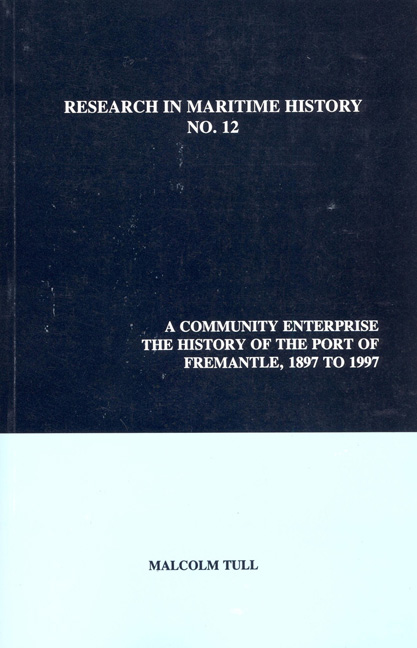Book contents
- Frontmatter
- Table of Contents
- List of Tables
- List of Figures
- List of Photos
- Acknowledgements
- Abbreviations
- Conversions
- Introduction
- Chapter 1 The Birth of A Modern Port
- Chapter 2 The Establishment of The Fremantle Harbour Trust
- Chapter 3 The Development Of Trade At The Port of Fremantle
- Chapter 4 The Shipping of Fremantle
- Chapter 5 A Century of Port Development, 1897 To 1997
- Chapter 6 Cargo-Handling Technology, Working Conditions And Industrial Relations on The Fremantle Waterfront
- Chapter 7 From Port Authority To Strategic Manager: The Transformation of The FPA
- Appendix A Trade and Shipping Statistics
- Appendix B Financial Statistics
- Appendix C Labour Statistics
- Appendix D
- Bibliography
- Index
Chapter 3 - The Development Of Trade At The Port of Fremantle
- Frontmatter
- Table of Contents
- List of Tables
- List of Figures
- List of Photos
- Acknowledgements
- Abbreviations
- Conversions
- Introduction
- Chapter 1 The Birth of A Modern Port
- Chapter 2 The Establishment of The Fremantle Harbour Trust
- Chapter 3 The Development Of Trade At The Port of Fremantle
- Chapter 4 The Shipping of Fremantle
- Chapter 5 A Century of Port Development, 1897 To 1997
- Chapter 6 Cargo-Handling Technology, Working Conditions And Industrial Relations on The Fremantle Waterfront
- Chapter 7 From Port Authority To Strategic Manager: The Transformation of The FPA
- Appendix A Trade and Shipping Statistics
- Appendix B Financial Statistics
- Appendix C Labour Statistics
- Appendix D
- Bibliography
- Index
Summary
The Port of Fremantle has been a vital link in almost every phase of Western Australia's development; its shipping and trade a barometer of the state's prosperity. The import trade of the port began in 1829 with the unloading of the colonists, their personal effects and stores from the Ñ armella. In 1832 wool exports began with a tiny shipment of three tons; other exports to develop during the nineteenth century included fisheries products, sandalwood, timber, gold and, at the turn of the century, grain. In 1903-1904 Fremantle's import and export trade totalled 692,000 tons and was carried in about 800 ships totalling 1.4 million net registered tons (nrt). By 1995-1996 trade had grown to 20.2 million tonnes and was carried in 1,758 ships totalling 33.5 million gross registered tons (grt). Therefore, over almost a century, trade had increased by about 2800 percent in tonnage terms, the number of ships calling had risen by 120 percent, and the tonnage of shipping had increased by about 2300 percent. During this period Fremantle remained Western Australia's leading passenger port, although the rapid growth of air travel after the Second World War caused passenger movements to plummet. These summary statistics suggest that Fremantle experienced major changes in cargo and passenger flows and ship movements during the first century of the port's operation.
The objective of this chapter is to identify and explain the major changes in cargo and passenger flows between the 1890s and the 1990s; ship movements will be considered in the next chapter. In order to explain trade and passenger flows we examine a variety of factors, including economic ones such as the growth of population, incomes and industry and the state of overseas trade, while political factors such as government tariff and trading policies, and industrial militancy cannot be neglected. It will be argued that to a large degree Fremantle's fortunes as a port were not determined by local decisions of port operators and users, but by wider forces emanating from the state, national and even international spheres. But before we can consider these factors it is necessary to briefly discuss the measurement of port activity.
There are a number of possible measures of port activity including the tonnage of cargo handled; the value of cargo handled; the capacity of ships using a port; and the number of ships calling.
- Type
- Chapter
- Information
- A Community EnterpriseThe History of the Port of Fremantle, 1897 to 1997, pp. 51 - 96Publisher: Liverpool University PressPrint publication year: 1997



